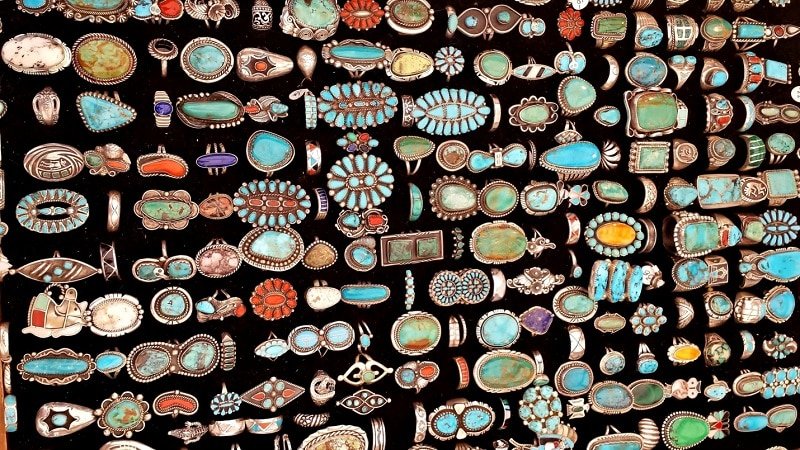How to Tell If a Turquoise Is Real

With striking blue color and a medieval feel to it, turquoise is appealing and one of the most prized gemstones of the world. First introduced by the Turks to the Eastern European region, today this December birthstone is reputed for its glorifying history and use in jewelry worldwide.
Many may believe that there are the tinges of greens and blue hues to turquoise. However, according to Gem Society, turquoise is found in crystal blue, dark blue to pale blue, green, blue-green, apple green, and even grayish-green, amongst many more shades. This shows that while the semi-precious gemstone has its rarities, it isn’t that difficult to replicate.
Nowadays, almost everything can be found in its high-grade replica form, semi-precious gemstones like turquoise are no exception. It is definitely one of the most beautiful and popular stones out there. However, just as much as people love to own the stone in jewelry and ornaments, it is important to make sure you are getting the real deal because believe it or not but almost 90% of the turquoise you come across regularly turns out to be fake.
Therefore, here are some tips that can help you identify a fake turquoise from a real one.
- Know what a faketurquoise
- Look closely to for a unique appearance.
- Always question the price and weight.
- Conduct a series of tests like a fingernail test, scratch test, acetone test, etc.
Now let’s discuss in detail how these tips can help you identify if your turquoise is indeed real or not.
Howlite – Fake Turquoise
It can be a tricky job to be able to identify a fake turquoise because of how much the stone itself varies in colors and patterns. Also, not to mention the top-notch quality of even fake stones these days that are made to look as closely identified as possible. Hence, it is essential to know what exactly a fake turquoise is so that you can spot a difference. Typically, the soft mineral known as howlite is used to replace turquoise, which is dyed to mimic the articulate details of the semi-precious stones. Similarly, plastic, resin, and epoxy have also found use in the jewelry industry as they are easy to mimic semi-precious stones like turquoise.
Attention to Detail
Now that you know what a fake turquoise is, it becomes easier to spot a fake one. Given how you will now give more attention to the appearance and detailing of the stone, you have a high chance to pick a real one from a fake. It takes a keen eye with persistent attention to detail to do so and may even take you some practice. Understandably, you are no expert, and noting the difference between a fake turquoise and a real can be difficult. However, the unique appearance of turquoise is one of its kind, and a true gemstone lover can spot it.
Pricing and Weight
It is absolutely essential to double-check the price and weight of the stone you are purchasing. As there are so many high-quality replicas going about, the chance of you purchasing a fake one for a real price is high. Therefore, be wary of such scammers that will sell you a fake when you thought you are purchasing a real deal. Make sure you ask them to check the weight of the stone in front of you and get a second opinion on pricing from a reliable stone expert. Moreover, buy ready-made jewelry pieces only from trustworthy jewelers and don’t go for an instinctive buying spree expecting to get a real turquoise fitted in random materials.
Conducting Tests
There are certainly easy-to-do tests that have promising results to help you identify a fake turquoise.
o The Finger-Nail Test
If you place the edge of your fingernail and move it across the surface of the stone, you may feel minor cracks. These cracks are not actually indicative of a broken or weak stone structure. Instead, it is the area where the turquoise meets the webbing matrix creating the unique patterns on the stone. If you have a natural rough stone in your possession and your fingernail gets caught in these cracks, the result is in your favor, and you have a real turquoise.
o The Scratch Test
The scratch test is an alternative if you cannot simply identify a howlite or resin replica from a real turquoise. Scratching the surface of the stone would allow you to feel the hardness. Therefore, because howlite or resin and epoxy replicas are softer than the real turquoise gemstone, the scratch test is a great identifier if you have a fake or real one in your hands.
o The Acetone Test
Do remember that this test may damage the fake stone. In case you don’t want to damage it and just find out so that you can replace it or give it back to where you got it from, don’t use this test. Because naturally, what acetone does is that it takes away the color or the dye of the fake stone. So you might want to rub the underside or the side that is hidden from obvious sightings to find out if you have a real stone or a high-quality plastic replica.
Our Final Thoughts
These methods mainly involve observation, a keen understanding of the stone, and some tricks here and there to identify a fake gemstone. So now that you know how to tell if turquoise is real or fake, hopefully, you will be able to get your hands on the real deal. Cheers!